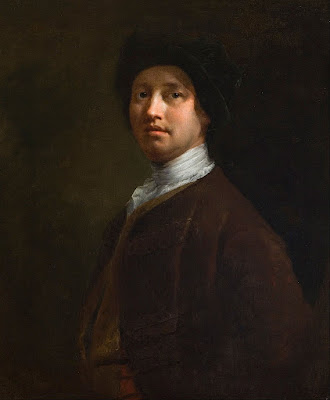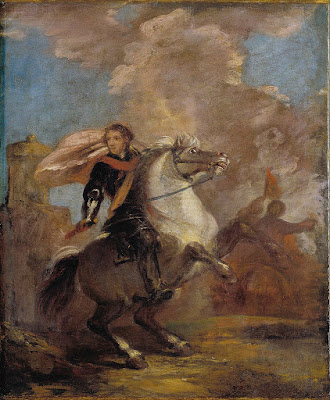 |
| Joshua Reynolds Portrait of the Ladies Waldegrave 1780 oil on canvas National Gallery of Scotland, Edinburgh |
Sir Joshua Reynolds (1723-1792) became the dominant authority on the art of painting in England during the second half of the 18th century, but his own practice as a portrait painter was notorious even in his own day for the instability of his pigments. In the first group of Reynolds portraits gathered here, the complexions of the sitters appear ghostly pale with blotchy red cheeks. This was not the effect Reynolds originally created in the studio. He had devised an idiosyncratic mixture of pigments to achieve the underlying pink flesh-tones he wanted, followed by a pink glaze mixed from a different range of pigments for the cheek-blushes. Sad to say, the red pigment in the underlying flesh tone was particularly unstable and quickly faded, leaving white pigment behind and producing skin that looked like plaster, while the alternative red pigment in the blushes retained its intensity and soon began to appear grossly exaggerated.
 |
| Joshua Reynolds Portrait of Master Bunbury 1780-81 oil on canvas Philadelphia Museum of Art |
 |
| Joshua Reynolds Portrait of Mrs Elisha Mathew 1777 canvas Museum of Fine Arts, Houston |
 |
| Joshua Reynolds Portrait of Sarah Campbell 1777-78 oil on canvas Yale Center for British Art |
 |
| Joshua Reynolds Portrait of Lady Elizabeth Delmé and her children ca. 1777-79 oil on canvas National Gallery of Art, Washington DC |
Earlier in his career, when Reynolds painted his own portrait in the late 1740s (immediately below) he demonstrated that he did indeed understand how to mix durable pigments for credible skin-tones that would not self-destruct. His own face has consequently survived in far better shape than the faces of his fashionable clients. What is amazing – given the scale of his blunders and the pretentiousness of his pronouncements – is how high Reynolds's artistic reputation remains even today. Impatient and sloppy as a painter, he yet possessed an uncanny talent for attracting institutional prestige.
 |
| Joshua Reynolds Self-portrait ca. 1745-49 oil on canvas Savannah College of Art and Design |
 |
| Joshua Reynolds Portrait of Richard Peers Symons MP 1770-71 oil on canvas Cincinnati Art Museum |
In the background of the portrait immediately above, a miniature Farnese Hercules with its back turned echoes the pose of the green-suited MP. The gaze of Hercules is directed toward the interior of the picture, down a vista like a tunnel leading to a lofty classical building, only slightly ruinous. Richard Peers Symons, the principle subject, is thus depicted with the utmost possible flattery gazing forward into the British future in the same spirit of prudent strength and mastery which the small doppelgänger behind him manifests with its gaze into the heroic past.
 |
| Joshua Reynolds Portrait of Lady Frances Finch 1781-82 oil on canvas National Gallery of Victoria, Melbourne |
 |
| Joshua Reynolds Portrait of Francis Rawdon Hastings 1789-90 oil on canvas Royal Collection, Windsor |
 |
| Joshua Reynolds Portrait of Miss Elizabeth Ingram 1757 oil on canvas Walker Art Gallery, Liverpool |
 |
| Joshua Reynolds Portrait of Lady Sunderlin 1786 oil on canvas Gemäldegalerie, Berlin |
 |
| Joshua Reynolds Equestrian portrait of Sir Jeffrey Amherst ca. 1768 oil on canvas Yale Center for British Art |
 |
| Joshua Reynolds An Officer on Horseback 1760s oil on canvas Dulwich Picture Gallery, London |
 |
| Joshua Reynolds Portrait of Mrs Siddons as the Tragic Muse 1789 oil on canvas Dulwich Picture Gallery, London |